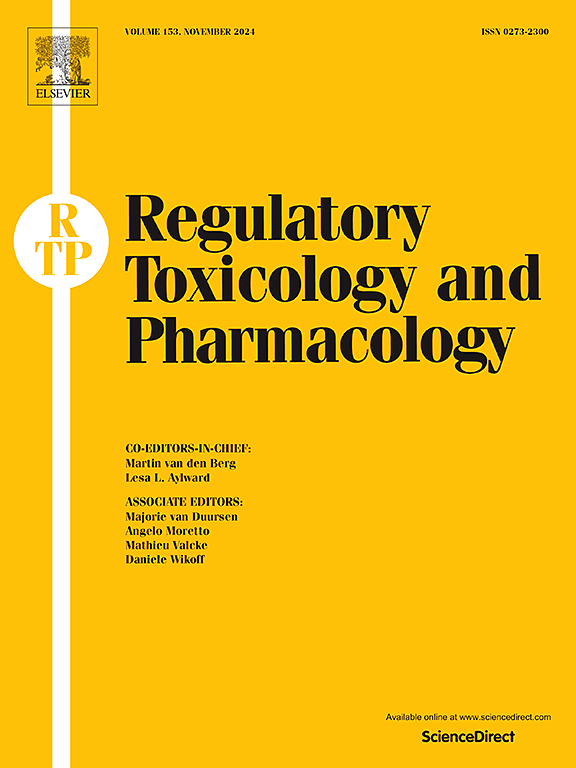纳米材料遗传毒性检测的监管实践及未来展望。
IF 3.5
4区 医学
Q1 MEDICINE, LEGAL
引用次数: 0
摘要
纳米材料的毒性与它们的物理化学性质密切相关,如大小、形状、表面化学、在生物介质中的稳定性、团聚状态以及它们被细胞吸收。近年来,标准化测试方法的主要缺陷已被发现并加以解决。在新方法方法(NAMs)的背景下,本工作的目的是回顾不同监管领域下NMs遗传毒性测试的现有方法,并从NAMs的发展角度来解决NMs风险评估中长期存在的困难。它严格审查了国际和欧盟的指导方针,强调了统一的必要性和NAMs推动下一代风险评估的潜力。然而,进一步的合作、研究和验证对于获得更广泛的接受和适用性至关重要。基于大数据、人工智能和机器学习的创新技术方法的贡献,可能为不同部门和分组策略之间的有力比较铺平道路,这将进一步推动纳米毒理学研究的创新。纳米颗粒遗传毒性检测的未来前景将取决于监管机构、研究人员和行业利益相关者之间加强合作。克服当前障碍的关键步骤包括建立更清晰的数据共享途径、标准化测试协议以及促进更大的国际合作。本文章由计算机程序翻译,如有差异,请以英文原文为准。
Regulatory practices on the genotoxicity testing of nanomaterials and outlook for the future
The toxicity of nanomaterials(NMs) is closely tied to their physicochemical properties, such as size, shape, surface chemistry, stability in biological medium, and state of agglomeration as well to their uptake by cells. Key deficiencies in standardized testing approaches have been identified and tackled in recent years. Within the landscape of new approach methods (NAMs), the aim of this work is to review existing approaches for genotoxicity testing of the NMs under different regulatory domains, with a perspective on the development of NAMs that can solve longstanding difficulties in NMs’ risk assessment. It critically examines international and European Union guidelines, highlighting the need for harmonization and the potential of NAMs to drive next-generation risk assessment. However, further collaboration, research and validation are essential to gain wider acceptance and applicability. The contribution of innovative technological approaches based on big data, artificial intelligence and machine learning, may pave powerful comparisons among different sectors and grouping strategies that will furtherance innovation in the nanotoxicology research. The future outlook for the genotoxicity testing of NMs will depend on increased cooperation between regulatory agencies, researchers, and industry stakeholders. Key steps toward overcoming current obstacles include establishing clearer pathways for data sharing, standardizing testing protocols, and fostering greater international collaboration.
求助全文
通过发布文献求助,成功后即可免费获取论文全文。
去求助
来源期刊
CiteScore
6.70
自引率
8.80%
发文量
147
审稿时长
58 days
期刊介绍:
Regulatory Toxicology and Pharmacology publishes peer reviewed articles that involve the generation, evaluation, and interpretation of experimental animal and human data that are of direct importance and relevance for regulatory authorities with respect to toxicological and pharmacological regulations in society. All peer-reviewed articles that are published should be devoted to improve the protection of human health and environment. Reviews and discussions are welcomed that address legal and/or regulatory decisions with respect to risk assessment and management of toxicological and pharmacological compounds on a scientific basis. It addresses an international readership of scientists, risk assessors and managers, and other professionals active in the field of human and environmental health.
Types of peer-reviewed articles published:
-Original research articles of relevance for regulatory aspects covering aspects including, but not limited to:
1.Factors influencing human sensitivity
2.Exposure science related to risk assessment
3.Alternative toxicological test methods
4.Frameworks for evaluation and integration of data in regulatory evaluations
5.Harmonization across regulatory agencies
6.Read-across methods and evaluations
-Contemporary Reviews on policy related Research issues
-Letters to the Editor
-Guest Editorials (by Invitation)

 求助内容:
求助内容: 应助结果提醒方式:
应助结果提醒方式:


